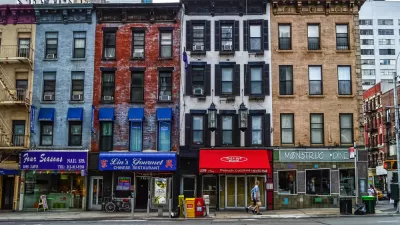Students in Ohio State University's City and Regional Planning department worked closely with the Franklinton neighborhood in Columbus to create a new vision for the community.
"Throw a stick from any corner along Columbus' east-west artery of Broad Street and you'll likely hit an area that somebody hopes will become the city's next great urban neighborhood. But few have drawn as much consideration as the historic area of Franklinton, made viable this century by its location in the morning shadow of Downtown and the completion of the Scioto River floodwall.
Last week, a group of master's candidates in OSU's Knowlton School of Architecture's City and Regional Planning program unveiled an extensive, deeply researched plan for the neighborhood, called for by the Franklinton Development Association.
Mark Lundine is one of the students responsible for the plan. Having worked on the city's 2012 initiative as an intern, he was well acquainted with the growing desire for affordable urban housing, as well as space and ownership for artists that have been priced out of the Short North.
Lundine spoke to Alive about the five key principles that would guide Franklinton development."
FULL STORY: On principles

Manufactured Crisis: Losing the Nation’s Largest Source of Unsubsidized Affordable Housing
Manufactured housing communities have long been an affordable housing option for millions of people living in the U.S., but that affordability is disappearing rapidly. How did we get here?

Americans May Be Stuck — But Why?
Americans are moving a lot less than they once did, and that is a problem. While Yoni Applebaum, in his highly-publicized article Stuck, gets the reasons badly wrong, it's still important to ask: why are we moving so much less than before?

Using Old Oil and Gas Wells for Green Energy Storage
Penn State researchers have found that repurposing abandoned oil and gas wells for geothermal-assisted compressed-air energy storage can boost efficiency, reduce environmental risks, and support clean energy and job transitions.

Updating LA’s Tree Rules Could Bring More Shade to Underserved Neighborhoods
A new USC study finds that relaxing Los Angeles’ outdated tree planting guidelines could significantly expand urban tree canopy and reduce shade disparities in lower-income neighborhoods, though infrastructure investments are also needed.

California's Canal Solar Projects Aim to Conserve Resources and Expand Clean Energy
California’s Project Nexus has begun generating electricity from solar panels installed over irrigation canals, with researchers and state agencies exploring statewide expansion to conserve water and boost clean energy production.

HHS Staff Cuts Gut Energy Assistance Program
The full staff of a federal program that distributes heating and cooling assistance for low-income families was laid off, jeopardizing the program’s operations.
Urban Design for Planners 1: Software Tools
This six-course series explores essential urban design concepts using open source software and equips planners with the tools they need to participate fully in the urban design process.
Planning for Universal Design
Learn the tools for implementing Universal Design in planning regulations.
Heyer Gruel & Associates PA
City of Moreno Valley
Institute for Housing and Urban Development Studies (IHS)
City of Grandview
Harvard GSD Executive Education
Salt Lake City
NYU Wagner Graduate School of Public Service
City of Cambridge, Maryland





























